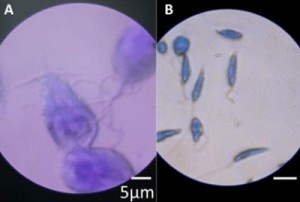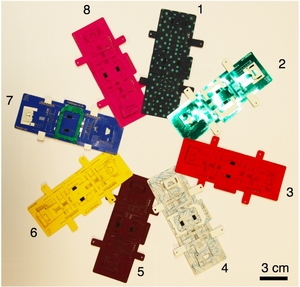– Stanford bioengineer develops a 50-cent paper microscope (Scope Blog, March 10, 2014):
When Manu Prakash, PhD, wants to impress lab visitors with the durability of his Origami-based paper microscope, he throws it off a three-story balcony, stomps on it with his foot and dunks it into a water-filled beaker. Miraculously, it still works.
Even more amazing is that this microscope — a bookmark-sized piece of layered cardstock with a micro-lens — only costs about 50 cents in materials to make.
In the video posted above, you can see his “Foldscope” being built in just a few minutes, then used to project giant images of plant tissue on the wall of a dark room.
Prakash’s dream is that this ultra-low-cost microscope will someday be distributed widely to detect dangerous blood-borne diseases like malaria, African sleeping sickness, schistosomiasis and Chagas.
“I wanted to make the best possible disease-detection instrument that we could almost distribute for free,” said Prakash. “What came out of this project is what we call use-and-throw microscopy.”
The Foldscope can be assembled in minutes, includes no mechanical moving parts, packs in a flat configuration, is extremely rugged and can be incinerated after use to safely dispose of infectious biological samples. With minor design modifications, it can be used for bright-field, multi-fluorescence or projection microscopy.
One of the unique design features of the microscope is the use of inexpensive spherical lenses rather than the precision-ground curved glass lenses used in traditional microscopes. These poppy-seed-sized lenses were originally mass produced in various sizes as an abrasive grit that was thrown into industrial tumblers to knock the rough edges off metal parts. In the simplest configuration of the Foldscope, one 17-cent lens is press-fit into a small hole in the center of the slide-mounting platform. Some of his more sophisticated versions use multiple lenses and filters.
To use a Foldscope, a sample is mounted on a microscope slide and wedged between the paper layers of the microscope. With a thumb and forefinger grasping each end of the layered paper strip, a user holds the micro-lens close enough to one eye that eyebrows touch the paper. Focusing and locating a target object are achieved by flexing and sliding the paper platform with the thumb and fingers.
Because of the unique optical physics of a spherical lens held close to the eye, samples can be magnified up to 2,000 times. (To the right are two disease-causing microbes, Giardia lamblia and Leishmania donovani, photographed through a Foldscope.)
The Foldscope can be customized for the detection of specific organisms by adding various combinations of colored LED lights powered by a watch battery, sample stains and fluorescent filters. It can also be configured to project images on the wall of a dark room.
In addition, Prakash is passionate about mass-producing the Foldscope for educational purposes, to inspire children — our future scientists — to explore and learn from the microscopic world.
In a recent Stanford bioengineering course, Prakash used the Foldscope to teach students about the physics of microscopy. He had the entire class build their own Foldscope. Then teams wrote reports on microscopic observations or designed Foldscope accessories, such a smartphone camera attachment.
For more on Foldscope optics, a materials list and construction details, read Prakash’s technical paper.
– Foldscope: Microscopy for everyone:
We are a research team at PrakashLab at Stanford University, focused on democratizing science by developing scientific tools that can scale up to match problems in global health and science education. Here we describe Foldscope, a new approach for mass manufacturing of optical microscopes that are printed-and-folded from a single flat sheet of paper, akin to Origami.
New: We are currently looking for beta-testers for Foldscope. We will be choosing 10,000 people who would like to test the microscopes in a variety of settings and help us generate an open source biology/microscopy field manual written by people from all walks of life. See “Ten Thousand Microscopes signup” for details.
Foldscope is an origami-based print-and-fold optical microscope that can be assembled from a flat sheet of paper. Although it costs less than a dollar in parts, it can provide over 2,000X magnification with sub-micron resolution (800nm), weighs less than two nickels (8.8 g), is small enough to fit in a pocket (70 × 20 × 2 mm3), requires no external power, and can survive being dropped from a 3-story building or stepped on by a person. Its minimalistic, scalable design is inherently application-specific instead of general-purpose gearing towards applications in global health, field based citizen science and K12-science education.



Where can I buy already constructed Foldscopes for my very young students?
I would like to know if this incredible invention is available in the UK. if so where.